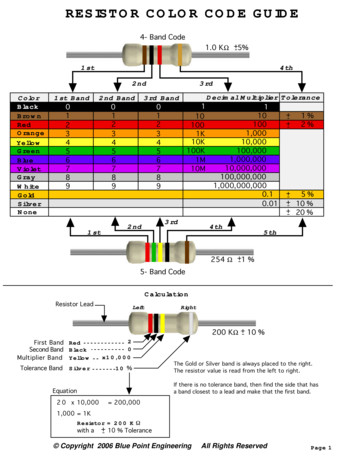Description Of Teaching Strategies Gold Online
DEPARTMENT OF FAMILY SUPPORT AND SERVICESFALL DATA ANALYSIS 2018-2019Description of Teaching Strategies Gold Online Assessment ToolTeaching Strategies GOLD Online Assessment System is a reliable and valid assessment that measures theknowledge, skills, and behaviors that are most predictive of school success. The assessment has 36 objectives,including 2 objectives related to English language acquisition. Thirty-six objectives are organized into nine areas ofdevelopment and content learning. The four areas of development are social-emotional, physical, language, andcognitive. The content learning areas are literacy, mathematics, science and technology, social studies, and thearts. The objectives are aligned to the Illinois Learning Standards and the Head Start Child Development and EarlyLearning Framework. The assessment is used to assess all 0-5 children funded by DFSS programs. The assessmentis used both as a formative and a summative assessment. The summative assessment checkpoints are Fall (10-29),Winter (2-14), Spring (5-31) and Summer (8-14). The summer checkpoint session solely looks at the progress madefor those children going to kindergarten.Fall Data 2018-2019 Demographics: Fall Checkpoint Season date range: August 15th to October 29thData in the report represents all DFSS HS/EHS/EHSCCP funded children: 16,58951% of the children are males and 49% are females41% of the children are Prek-4 meaning they are going to kindergarten35% are Pre-k 3-4 years old13% are children 2 to 3 years old7% are children 1 to 2 years old4% are children birth to 1 years old16% of the Children identified as Spanish speaking and 1% speaks Chinese.Fall Data Collection Period: August 15th to October 29thThe Snapshot report was generated to assess the skill set children entered with for program year 2018-2019.TheSnapshot Report functions like photograph, capturing information about individual children and groups of childrenat one point in time. The report enables both administrators and teachers to best understand how to supporteach child’s continued development and learning during the upcoming year. Analysis of the report will informneeded professional development, how best to align the curriculum to the needs of children and what resourceswill best support parents in working with their children.1
DEPARTMENT OF FAMILY SUPPORT AND SERVICESFALL DATA ANALYSIS 2018-2019Fall Checkpoint Season Below /Meeting/Exceeding Widely Held Expectations: 16,589Children AssessedEach table represents an area of development or area of content learning. The charts identify the percentage ofchildren’s skills, knowledge and behaviors that are below/meeting/exceeding widely held expectations (WHE) fortheir age group.Widely Held Expectations for Social Emotional100%80%60%40%20%0% 88%65%62%59%39%72%34%32%25%4%1%3%2%8%5%Blue 4-5yr.Green 3-4yr.Yellow 3yr.Orange 2yr.Red eeding1%4%3%2%5%Percentage of children not meeting WHE during the Fall are typical high since it is their first school experience.Kindergarten bound children have the highest percentage of not meeting for this area.Widely Held Expectations for Physcial100%80%60%40%20%0% 79%70%68%65%49% 51%28%30%27%4%1%5%3%16%4%Blue 4-5yr.Green 3-4yr.Yellow 3yr.Orange 2yr.Red ceeding1%4%3%5%4%Kindergarten bound children have the highest percentage of not meeting for this area.Children in the 2yr. old age group also demonstrated a high percentage of not meeting WHE. One would wantto exam the physical environments for this age group to ensure environments are arranged in a way thatsupports physical development.2
DEPARTMENT OF FAMILY SUPPORT AND SERVICESFALL DATA ANALYSIS 2018-2019Widely Held Expectations for Language80%70%60%50%40%30%20%10%0% 76%54%58%45%57%47%40%39%52%22%3%1%2%2%1%Blue 4-5yr.Green 3-4yr.Yellow 3yr.Orange 2yr.Red ceeding1%3%2%1%2%Children going to Kindergarten/Blue age group have the highest percentage of children not meeting WHE forthe Fall checkpoint.Children in the 2-3 age range also have a high percentage of not meeting WHE. Routines and experiencesshould be assessed to ensure caregivers are expanding children's vocabulary and conversing withchildren during routines and experiences.Widely Held Expectations for Cognitive100%80%60%60%57%40%40%30%40%20%0% 84%80%67%18%3%0%3%3%11%5%Blue 4-5yr.Green 3-4yr.Yellow 3yr.Orange 2yr.Red ceeding0%3%3%3%5%Children going to Kindergarten/Blue age group have the highest percentage of children not meeting WHE forthe Fall checkpoint.3
DEPARTMENT OF FAMILY SUPPORT AND SERVICESFALL DATA ANALYSIS 2018-2019Widely Held Expectations for Literacy100%80%60%57%57%47% 49%43%39%40%20%0% 92%80%4%0%4%16%4%8%0%Blue 4-5yr.Green 3-4yr.Yellow 3yr.Orange 2yr.Red eeding0%4%4%4%8%Kindergarten bound children have the highest percentage of not meeting for this area.The 2-3 yr. old age group has a high percentage for this area.Widely Held Expectations for Math120%97%100%80%74%40%40%0% 36%25%20%66%61%54%60%31%6%1%3%3%3%0%Blue 4-5yr.Green 3-4yr.Yellow 3yr.Orange 2yr.Red eeding1%6%3%3%3%Kindergarten bound children have the highest percentage of not meeting for this area.The 2-3 yr. old age group has a high percentage for this area.4
DEPARTMENT OF FAMILY SUPPORT AND SERVICESFALL DATA ANALYSIS 2018-2019Gold Readiness Report / Kindergarten EntryThe Gold Readiness report was used to analyze children who are going to Kindergarten next year. The GoldReadiness Report enables users to compare children’s scores to a readiness benchmark which looks at a child’sreadiness towards kindergarten entry (entry skills). The chart shows the percentage of children whose skills,knowledge and behaviors are emerging (below benchmark value) or accomplished (at or above the benchmarkvalue). In analyzing the report, the data informs that for all areas of development and content learningkindergarten bound children are not meeting the bench mark. Moving forward teachers should target/aligncurriculum planning and individualization for these children to ensure progress in meeting Gold ReadinessBenchmarks.Gold Readiness Fall hed14.86%20.29%14.29%11.78%7.70%5.14%5
DEPARTMENT OF FAMILY SUPPORT AND SERVICESFALL DATA ANALYSIS 2018-2019Comparing Gender Progress: 51% Boys / 49% GirlsThe Fall assessment data was filtered according to gender to answer the question, is there a difference in skill levelassociated to gender? Current research notes that gender influences behavior, learning styles and how teachersreact to those differences can influence how and what a child learns. In reviewing Fall data for gender, it identifiesthat boys were behind girls in all areas of development by several points starting at the beginning of Preschool.Interesting trend noted is that boys during the first three years of life scored similar or within several points of girlsbut beginning at the preschool the gap became significant. The Fall data set identified the largest disparity (7 to 8points) in the areas of Social/Emotional, Physical and yMathBirth to 1yr.SocialEmotionalBoys Girls88% ys91%Girls93%Boys96%Girls98%1yr. to 2yrs.72%72%65%63%50%54%79%80%78%82%65%68%2yrs to %42%50%38%43%39%47%24%26%Considerations:In review of the current research several essential steps have been identified to support the development andlearning of boys.Teacher and Parent Training on different learning styles and implications for supporting a child’s individual learningstyle.Strategies for teachers to use in their Classrooms: Incorporating boy’s interests into large or small group planning.Start with books in small groups especially those with pictures of real people and things.Expect to change room environment and schedule for boy-generated activities ie; construction area,working with tools, building, movement/dance with props.Increase the use of graphics and pictures in working with boys to recall and document their learning.Boys learn best through a project approach . where the learning is more kinesthetic. Ensure aproject/study approach to learning is implemented on a consistent basis.6
DEPARTMENT OF FAMILY SUPPORT AND SERVICESSchool Readiness GoalsManages FeelingsFollows limits and expectationsTakes care of own needsForms relationships with adultsResponds to emotional cuesInteracts with peersDemonstrates traveling skillsDemonstrates balancing skillsDemonstrates gross motor skillsUses fingers and handsComprehends LanguageFollows directionsUses an expanding expressive vocabularySpeaks clearlyUses conventional grammarAttends and engagesPersistsSolves ProblemsShows curiosity and motivationRecognizes and RecallsMakes connectionsUses and appreciates booksWrites nameWrites to convey meaningCountsQuantifiesUnderstands spatial relationshipsUnderstands shapesCompares and measuresDemonstrates knowledge of patternsFALL DATA ANALYSIS 2018-2019Alignment toGoldObjectives 1d12a12b17a19a19b20a20b21a21b2223Percentage of 52%62%57%57%60%62%65%The Gold objectives are aligned to the Illinois Learning Standards and the Head Start Child Development and EarlyLearning Framework. There are 30 school readiness goals identified by DFSS. The percentage of all childrenmeeting/exceeding for the Fall checkpoint has been identified for each objective. One would expect at thebeginning of the year that percentages of all children meeting School Readiness Goals would be a range above65% to 80%. Planning and curriculum alignment should ensure intentionally planned learning experiences thatfocus on those Objectives that fall at or below 65% (highlighted)7
DEPARTMENT OF FAMILY SUPPORT AND SERVICESFALL DATA ANALYSIS 2018-2019Key Take Aways and Considerations: One would expect high percentages of children not meeting widely held expectations in the Fall since thismay be a child’s first school experience. The Fall checkpoint season is the shortest collection period. Thepurpose of the this first data collection period is to assess what skills children have upon entering toalign/individualize the curriculum to support development and learning. Percentages appear to be highfor all age groups except for the 0-1 yr. old age group.A trend noted in the analysis is that the Pre-K-4 group/Kindergarten bound children have the highestpercentage of children not meeting widely held expectations across all areas of development. Areas ofspecific concern are Social Emotional, Cognitive, and Math.Noted pattern for children in the 0-3 age group is that the older one is in this age range the higherpercentage of children not meeting WHE.Children in the 1- 2yr. old age group demonstrated a high percentage of not meeting WHE for physicaldevelopment. One would want to exam the physical environments for this age group to ensureenvironments are arranged in a way that supports physical development.Caregivers for 0-3 need to examine how they are incorporating Language and Math vocabulary duringdaily routines and experiences. Routines and experiences should be assessed to ensure caregivers areexpanding children’s vocabulary and conversing with children.Program Administrators for 3-5 center base should revisit teacher fidelity scores for item 14 (teacherplanned activities/experiences for language and literacy) and 15 (planned experiences for mathematicalconcepts) to ensure indicators not observed have been addressed and appropriate coaching strategies inplace.Program Administrators for 0-3 should revisit teacher fidelity scores for Physical Environment, Structureand Teacher Child Interactions to ensure curriculum practices are supporting this age groups developmentand learning.Ensure teachers are using their informative assessment data for planning. (Class Profile andDocumentation Status Report)Support teacher use of the Digital Resources; specifically, the Intentional Teaching Cards in addressingSchool Readiness GoalRecommended Professional Development and Resources: Training on Digital Resources to ensure teachers and caregivers are individualizing plans for childrenbased on each child’s skill and development level.Creative Curriculum for Infants, Toddlers and Two’s 3rd Edition with an emphasis on the caregivers’ role insupporting the development of language and literacy skills during routines and experiences.Supporting Social-Emotional Development. (0-5)Supporting Mathematical Thinking. (0-5)Supporting Language and Literacy Development and Learning. (0-5)Coaching to Fidelity for IT2 coordinators, site managers to ensure caregivers are implementing thecurriculum with fidelityCoaching to Fidelity for Preschool coordinators, site managers to ensure reliability when implementingthe tool.Supporting Boys to Thrive During the Early Years (0-5)Teaching Strategies Support Portal and Online CoursesHead Start ECLKC websiteErikson Early Math Collaborative8
DEPARTMENT OF FAMILY SUPPORT AND SERVICESFALL DATA ANALYSIS 2018-2019Suggested Resources for Head Start and Early Head Start Parents Learning Games: at home activities parents can do with their children with an emphasis on Math andLanguage.Generate the Development and Learning Report for individualized at home activities.Head Start Resource Center: News You Can Use / MathReading Right from the Start: What Parents Can Do in the First Five Years.Math Right from the Start: What Parents Can Do in the First Five Years.9
Description of Teaching Strategies Gold Online Assessment Tool Teaching Strategies GOLD Online Assessment System is a reliable and valid assessment that measures the knowledge, skills, and behaviors that are most predictive of school success. The assessment has 36 objectives, including 2 objectives related to English language acquisition.
.56 ohm R56 Green Blue Silver.68 ohm R68 Blue Gray Silver.82 ohm R82 Gray Red Silver 1.0 ohm 1R0 Brown Black Gold 1.1 ohm 1R1 Brown Brown Gold 1.5 ohm 1R5 Brown Green Gold 1.8 ohm 1R8 Gray Gold 2.2 ohm 2R2 Red Red Gold 2.7 ohm 2R7 Red Purple Gold 3.3 ohm 3R3 Orange Orange Gold 3.9 ohm 3R9 Orange White Gold 4.7 ohm 4R7 Yellow Purple Gold 5.6 ohm 5R6 Green Blue Gold 6.8 ohm 6R8 Blue Gray Gold 8 .
Gold 6230 2.1 20 27.5 10.4 Y 125 Gold 6226 2.7 12 19.25 10.4 Y 125 Gold 6152 2.1 22 30 10.4 Y 140 Gold 6140 2.3 18 25 10.4 Y 140 Gold 6130 2.1 16 22 10.4 Y 125 Gold 5220 2.2 18 24.75 10.4 Y 125 Gold 5218R 2.1 20 27.5 10.4 Y 125 Gold 5218 2.3 16 22 10.4 Y 105 Gold 5217 3 8 11 10.4 Y 115 Gold 5215 2.5 10 13.75 10.4 Y 85 Gold 5120 2.2 14 19 10.4 Y .
Facilitator’s Guide: Teaching Strategies GOLD Enduring Understanding The Sure Start program is a high-quality, comprehensive and unique preschool program that includes Teaching Strategies GOLD and GOLDplus enhanced planning. The Teaching Strategies GOLDplus enhanced planning tool is a valuable online tool used by Sure Start
Gold Content 24 Karat pure gold (a color that cannot be duplicated) 18 Karat or marked 750 75 percent gold 14 Karat or marked 585 58.5 percent gold 12 Karat or market 500 50 percent gold Unless you have coinage or a wafer or bar of gold, the dealer usually cheats a little on gold content. Many jewelry pieces are gold plated;
2-KARAT (KT or kt) is a measure of fineness of gold. A gold karat is 1/24th part, or 4.1667 percent of the whole. The purity of a gold alloy is expressed as the number of the parts of gold it contains. An object that contains 16 parts gold and 8 parts alloying metal is 16 karat gold. Pure gold is 24 karat gold. HINT: king/karat
Modern teaching methods and strategies Part I . Language teaching methodology, or teaching in this sense, is a set of methods based on the same rules and having a common aim, e.g. to encourage students to use the language, involve the studentsFile Size: 732KBPage Count: 55Explore further150 Teaching Methodsteaching.uncc.eduTEACHING TECHNIQUES - Oneontaemployees.oneonta.edu/thomasrl/Y (PDF) 50 METHODS OF TEACHING.pdf GRACE SIKALEYA .www.academia.eduChapter 4 Current approaches and teaching methods .www4.ujaen.es/ gluque/Chapter4H Teaching Methods and Strategies: The Complete Guidewww.educationcorner.comRecommended to you b
Teaching Strategies Gold: 1a, 1b, 1c Children will be able to show an increasing ability to form positive relationships with adults and peers. Teaching Strategies Gold: 2a, 2b, 2c, 2d Physical Development & Health: Children will be able to show control of large muscles for movement, coordination and balance. Teaching Strategies Gold: 4a, 4b, 4c .
The London DayBreak Strategy is a day trading strategy that takes advantage of the London open trading range. It’s a momentum breakout strategy that only requires up to no more than 15-minutes of your time. The London DayBreak Strategy only makes use of two simple technical indicators: the MACD which is a trend-following momentum indicator and the 50-EMA. A buy signal is generated only when .























